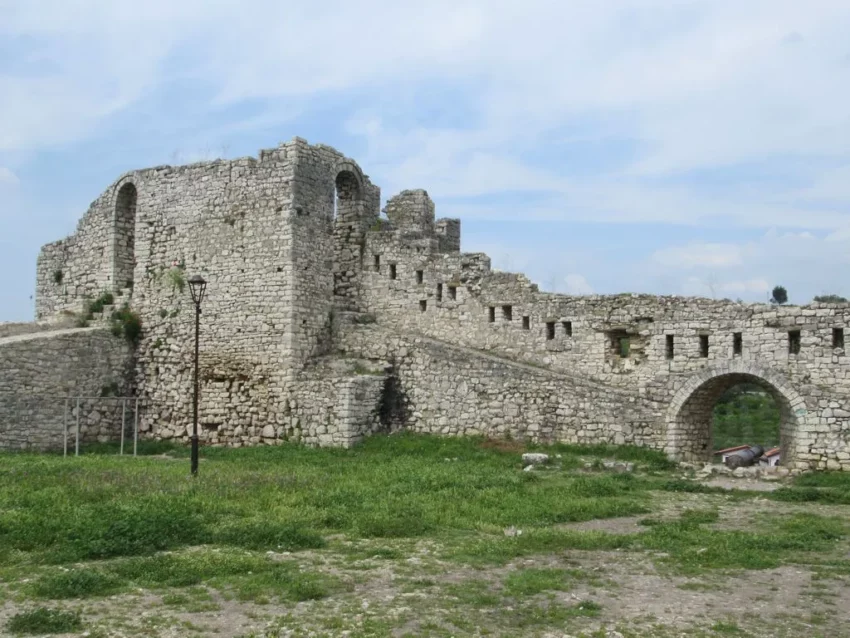Berat Castle, a historical fortress overlooking the town of Berat, Albania, stands as a testament to the region’s rich history. This imposing structure has been a silent witness to the ebb and flow of many civilizations. It has seen the rise and fall of empires, serving as a strategic military stronghold and a living community. Today, it is not only a symbol of Albania’s cultural heritage but also a popular tourist attraction, offering a glimpse into the past through its enduring walls and ancient artifacts.
Get your dose of History via Email
Historical Background of Berat Castle
The origins of Berat Castle trace back to the 4th century BC, with structures and fortifications built over time. Its strategic location on a rocky hill made it an ideal defensive position. The castle was expanded by the Byzantines in the 5th century AD and later by the Bulgarians. In the 13th century, it fell under the control of the Despotate of Epirus. The castle’s most significant expansion occurred under the Ottomans in the 13th and 14th centuries, who fortified it further and used it as an administrative center.
Throughout its history, Berat Castle has been a focal point during various conflicts. It has withstood many sieges due to its formidable defenses. The castle was also a hub for trade and governance, reflecting its importance beyond military might. Its walls have housed not only soldiers but also civilians, with many people living within its confines until the 20th century.
The castle’s discovery and documentation for historical studies began in earnest during the 19th century. European travelers and historians, fascinated by its architecture and history, started to record their observations. The castle was built by the Illyrians, with subsequent additions by the Romans, Byzantines, and Ottomans. Each left their mark on its architecture and design.
Berat Castle has been the scene of many historically important events. It played a role in the resistance against the Ottoman Empire and later during the Balkan Wars. In World War II, it was used as a stronghold by Italian and German forces. After the war, the castle’s historical significance was recognized, leading to preservation efforts.
Today, Berat Castle is not only a historical monument but also a living museum. It continues to be inhabited, with a small community residing within its walls. This unique aspect of the castle offers visitors a rare opportunity to experience history firsthand. The castle’s churches, mosques, and buildings are a testament to its diverse cultural and religious history.
About Berat Castle
Berat Castle stands on a rocky promontory above the river Osum. Its walls, built with locally sourced limestone and shale, enclose an area of 7.5 hectares. The castle’s layout reflects the various stages of construction and expansion it underwent. Its architecture is a mix of Hellenistic, Roman, Byzantine, and Ottoman styles.
The castle’s fortifications include numerous towers and bastions, each designed to maximize defense. The Red Tower is one of the most notable structures, famous for its resilience during sieges. The castle’s entrance, known as the Kala Gate, is a striking feature, with its high arch and fortified approach.
Inside the castle, visitors can explore a network of cobbled streets, lined with traditional houses and Byzantine churches. The Church of Saint Mary of Blachernae, with its 16th-century frescoes, is a highlight. The castle also houses the Onufri Museum, dedicated to the renowned Albanian icon painter.
The methods of construction reflect the ingenuity of the builders. The walls, often several meters thick, were built to withstand artillery. The use of local materials not only provided strength but also helped the castle blend with the natural landscape. The internal structures, including cisterns and storage rooms, demonstrate a sophisticated understanding of urban planning.
Berat Castle’s architectural highlights are not just defensive. The castle’s interiors feature intricate woodwork and stonemasonry, reflecting the artistic skills of its inhabitants. The blend of military, religious, and residential buildings within the castle creates a unique historical tapestry for visitors to explore.
Theories and Interpretations
Berat Castle’s history is steeped in legend and folklore. One theory suggests that the castle was built on the site of an ancient temple dedicated to the Greek goddess Aphrodite. However, concrete evidence to support this claim is scarce.
The castle’s use has been interpreted in various ways. While its primary function was military, it also served as a center of administration and commerce. Some historians believe that the castle’s churches were important pilgrimage sites during the Byzantine era.
There are mysteries surrounding certain aspects of the castle. For instance, the origins of some of the inscriptions and symbols found on the castle walls are still debated. These have been matched to historical records with varying degrees of success.
Dating the various phases of construction has been carried out using methods such as carbon dating and architectural analysis. These studies have helped establish a timeline for the castle’s development, although some periods remain less understood than others.
The interpretations of Berat Castle’s history are continually evolving. As new archaeological methods are developed and more research is conducted, our understanding of this historic fortress deepens. The castle remains an active site of historical inquiry and discovery.
At a glance
Country: Albania
Civilization: Illyrian, Roman, Byzantine, Ottoman
Age: Over 2,400 years (4th century BC to present)
Conclusion and Sources
The information in this article has been obtained from the following reputable sources:

